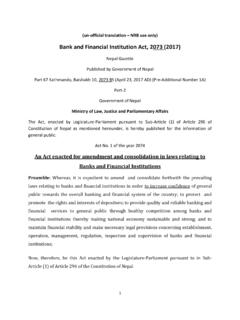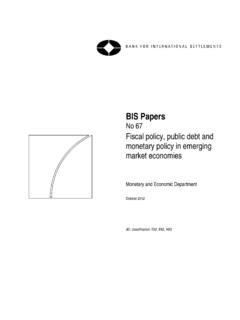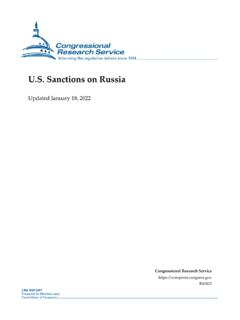Transcription of Monetary Policy for 2021/22
1 Unofficial Translation Monetary Policy for 2021/22 Nepal Rastra Bank Central Office Baluwatar, Kathmandu August 2021 Monetary Policy for 2021/22 Delivered by Governor Mr. Maha Prasad Adhikari on 13 August 2021 Nepal Rastra Bank Central Office Baluwatar, Kathmandu Nepal Rastra Bank Central Office Baluwatar, Kathmandu Nepal Phone: 4410158 Website: TABLE OF CONTENTS BACKGROUND .. 6 GLOBAL ECONOMIC SITUATION .. 7 DOMESTIC ECONOMIC SITUATION .. 8 FINANCIAL SECTOR SITUATION .. 9 REVIEW OF Monetary Policy 2020/21.
2 11 Monetary MANAGEMENT .. 11 SECTORAL CREDIT .. 12 COVID-19 TARGETED CREDIT .. 13 ECONOMIC OUTLOOK FOR 2021/22 .. 15 Monetary Policy FRAMEWORK FOR 2021/22 .. 16 Monetary Policy STANCE .. 16 ECONOMIC AND Monetary TARGET .. 16 OPERATING TARGET AND 17 FINANCIAL SECTOR PROVISIONS FOR 2021/22 .. 17 RESOURCE MOBILIZATION .. 17 CREDIT EXPANSION .. 17 SPECIAL PROGRAM FOR ECONOMIC RECOVERY .. 18 FINANCIAL SECTOR CONSOLIDATION .. 21 REGULATORY AND SUPERVISORY PROVISION .. 23 PROVISION REGARDING MICRO FINANCE .. 24 PAYMENT SYSTEM .. 24 FOREIGN EXCHANGE MANAGEMENT.
3 26 CONSUMER PROTECTION .. 27 Monetary Policy for 2021/22 Background 1. The Monetary Policy for 2021/22 has been formulated at a time when COVID-19 has adversely affected human life and overall economic activities. Policy measures, implemented to minimize the impact of the pandemic, have assisted in running economic activities, and maintaining macroeconomic and financial stability. 2. The COVID-19 pandemic has created hurdles towards the path of economic development and prosperity with social justice. Economic activities have been affected by recurring waves of COVID-19 infection.
4 Though exports have improved well, there has been pressure on the balance of payments due to a widening trade deficit driven by increasing imports. Foreign exchange reserve is in a comfortable position and inflation is within the target. 3. Refinancing and subsidized loan facilities, together with Monetary and regulatory easing, aimed to support economic recovery by minimizing the impact of COVID-19, have expanded the flows of credit in the economy. The business operating cost has remained at a lower level even during the pandemic because of the low lending rate at a single digit.
5 4. The use of digital means of payments has expanded rapidly in the recent period. Owing to the Policy of this bank to promote electronic transactions and the need for cashless transactions to minimize the potential risk of COVID-19 infection. Digital payments have been widely used in retail shops, wholesale businesses, departmental stores, and capital market transactions. It has supported the development and modernization of payment system as well as access to financial services. 5. As per the analysis of international organizations, the global economy seems to have started recovering after the COVID-19 shock with the use of the loose and extraordinary Policy measures by the majority of countries, and the availability of vaccines against COVID-19.
6 However, the pace of recovery is still expected to be slower in the countries which rely on tourism and for those lacking access to vaccines. 6. The recovery of the hard-hit sectors including the tourism is expected to take longer time for recovery due to continuation of infection. To speed up the economic recovery by minimizing the impact of the pandemic, it is necessary to provide regulatory easing and concessions, on the other hand, likely adverse impact on financial and external sector stability needs also to be considered cautiously.
7 7. Monetary Policy for 2021/22 has been formulated amidst the ongoing second wave of COVID-19, following the mandate of the Nepal Rastra Bank Act 2002. The Policy has been formulated considering the domestic and international economic outlook, common minimum program, policies, and priorities of the Government of Nepal, current macroeconomic situation of 2020/21, and the third strategic plan of this Bank. Suggestions from stakeholders are also duly considered while formulating Monetary Policy . Global Economic Situation 8.
8 According to the international Monetary fund (IMF), the world economy contracted by percent in 2020 and is projected to expand by 6 percent in 2021. The world economy expanded by percent in 2019. 9. The advanced economies contracted by percent in 2020 and are projected to expand by percent in 2021. Similarly, the emerging and developing economies contracted by percent in 2020 and are projected to expand by percent in 2021. The growth rate of developed economies, and emerging and developing economies stood percent and percent respectively in 2019.
9 10. Among neighboring countries, the IMF estimates show that the Chinese economy expanded by percent in 2019 and percent in 2020. Likewise, the fund has estimated the Indian economy to contract by percent in 2020 compared to the expansion of percent in 2019. Economic growth for China and India is projected to remain percent and percent respectively in 2021. 11. The IMF has projected inflation in the developed economies to remain at percent in 2021 compared to percent in 2020. The inflation of emerging and developing economies is projected to remain percent in 2021 compared to percent in 2020.
10 12. Global trade volume contracted by percent in 2020. It is projected to grow by percent in 2021. 13. The price of petroleum products dropped by percent in 2020. It is projected to increase by percent in 2021. 14. Revenue mobilization in most of the countries has been affected by the COVID-19. On the other hand, the increase in public expenditure has raised the ratio of public debt to gross domestic product globally. Such a ratio reached percent in 2020 compared to percent in 2019. 15. To speed up the recovery of the economy affected by the COVID-19 pandemic, central banks have adopted loose Monetary Policy including the instruments such as quantitative easing, asset purchases, refinancing, and long-term liquidity facilities.





![PsLs[t lgb]{zg, @)&*](/cache/preview/c/9/4/8/1/7/3/6/thumb-c9481736ff2a35d3e2563fbfd6c09f64.jpg)


![cfly{s jif{ @)&*÷&( sf] df}lb|s gLltsf] klxnf] q}dfl;s ;dLIff](/cache/preview/1/1/1/9/d/2/5/5/thumb-1119d255f839d189d645cf52a0f2f356.jpg)



